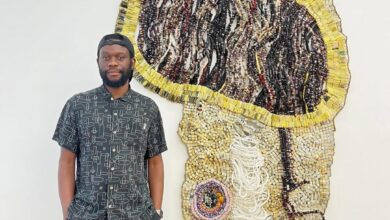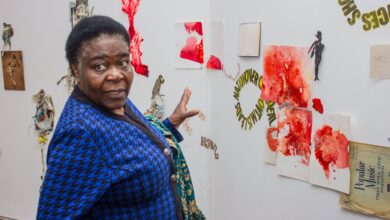Clive Mukucha’s Solo Exhibition at the National Gallery of Zimbabwe Captures the Aftermath of Calamity

Clive Mukucha’s latest solo exhibition, Chati Homu, Chareva, currently on display at the National Gallery of Zimbabwe, offers a haunting reflection on human suffering and resilience in the aftermath of great calamity. Through an arresting collection of sculptures crafted from found objects, Mukucha invites viewers to confront the unspeakable, challenging them to decipher metaphors often too potent to voice aloud.
Curated by Fadzai Muchemwa and Zvikomborero Mandangu, Chati Homu, Chareva unapologetically asserts the artist’s mission to articulate his truth. The exhibition positions Mukucha as a rising force in Zimbabwean contemporary art and a worthy disciple of the pioneering Tapfuma Gutsa.
Mukucha’s sculptures evoke the image of hollow men emerging from the graveyard—figures that feel at once fragile and unyielding. Dense lines and forms give way to three-dimensional sketches that seem to pulse with life and memory.
Central to the exhibition is Mukucha’s masterful use of found objects, each bearing its own history of use, neglect, and redemption. These materials are not selected for their aesthetic value alone but are intuitively combined to convey the profound suffering and resilience of humanity. The objects carry silent narratives, collectively constructing a visceral commentary on trauma, survival, and identity.
During a guided walkabout, it became evident that parts of Mukucha’s work resist verbal explanation. The artist himself occasionally veered into deliberate incoherence, allowing the art to speak where words falter. Moments of serendipity—when viewers identified layers he had not consciously considered—were met with his gracious and validating smile.
Subtle anatomical features such as eyes, noses, and mouths emerge from the abstract compositions, reinforcing the work’s immediacy and relevance. The sculptures resonate with urgency, their cryptic symbols inviting deep contemplation.
The exhibition presents a fully realised body of work, each piece contributing to the overarching narrative of calamity and transformation.
Benyumundiro explores the stark realities of hunger and starvation, portraying the primal instinct that awakens at the sight of food.
Rega zvipore, smeared with red paint suggestive of blood, embodies the healing process after fiery injury—a visceral metaphor for personal and collective wounds.
Kuchipepa kuchishizha, a triptych styled like an analogue film, underscores the importance of storytelling, especially narratives often suppressed to avoid reopening old wounds.
Mhindu pindu captures the unpredictable nature of life’s highs and lows.
Chivhitivhiti chemubhawa comments on the intersection of entertainment and exploitation in bar culture.
Yagojomorwa cleverly reimagines Zimbabwe’s map as a teapot caught in a turbulent cascade, a potent metaphor for national turmoil.
Manyerekupe ehondo conjures the tension of rumours of war, evoking alertness and distrust.
Dhunamutuna and Vasinamabvi engage with Zimbabwe’s anti-colonial history, loaded with deep political and cultural significance.
Joko addresses systemic oppression, unfair labour practices, and economic hardship.
Blazo and Yerobhoni stand as abstract yet deeply expressive portraits, showcasing the emotional depth of Mukucha’s practice.
Bindu raSabhuku transforms a symbol of abundance into one of destitution, challenging notions of prosperity.
Mudzimu weshiri highlights the vulnerability and protection inherent in both human and animal existence.
Mbuya mutegede, a term of endearment for a pregnant woman, is a layered abstraction ripe for interpretation.
Freedom of expression juxtaposes light and danger, symbolising both the liberating and perilous aspects of free speech.
Xenophobic emblem critiques the violence of xenophobia, particularly in the South African context, presenting it as a dangerous social pathogen.
Through this remarkable exhibition, Mukucha’s work touches on universal themes of capitalism, neoliberalism, consumerism, and climate change without explicitly framing them. Instead, he acts as an alchemist, transmuting suffering into heightened awareness and emotional resonance.
Like a piercing guitar solo that lingers long after the final note, Chati Homu, Chareva leaves an indelible impression. Mukucha’s sculptures, both haunting and hopeful, beckon viewers to confront the shadows of the past while seeking a more conscious future.




